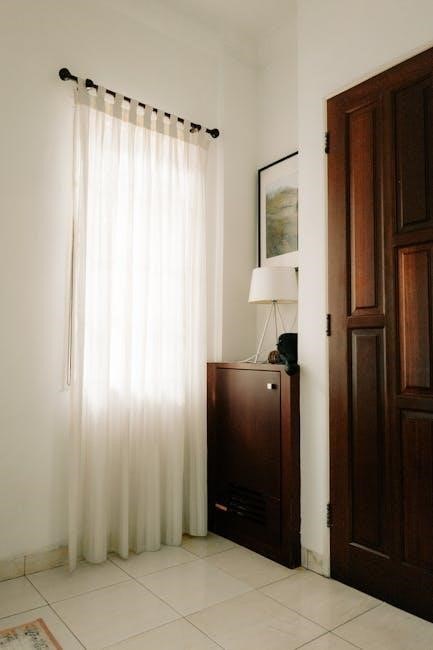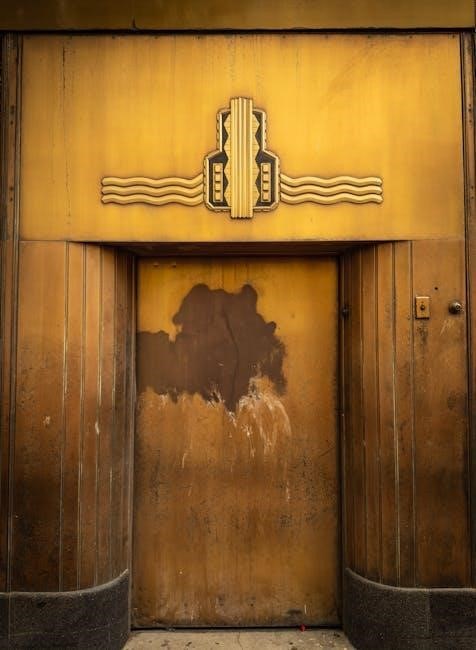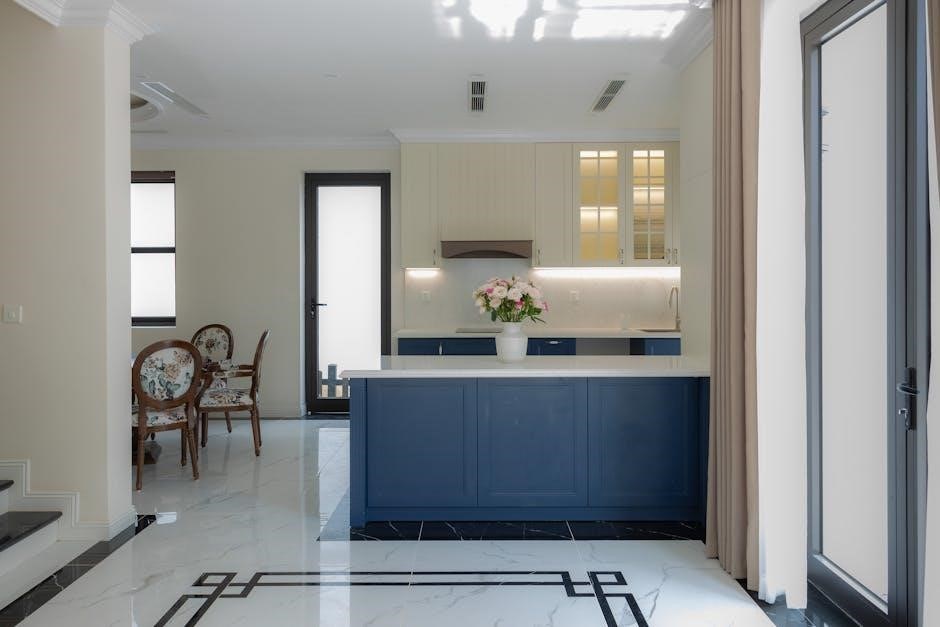A comprehensive door guide provides insights into selecting, installing, and maintaining doors, ensuring functionality, security, and aesthetic appeal for homes and buildings. From historical evolution to modern designs, doors play a crucial role in construction, offering privacy, safety, and energy efficiency while enhancing interior and exterior spaces.
1.1 Importance of Doors in Construction
Doors are essential in construction, providing security, privacy, and controlled access. They serve as barriers against noise, weather, and fire, while enhancing energy efficiency. Properly installed doors ensure smooth functionality, durability, and aesthetic appeal, making them a critical component in building design and safety. Their role in compartmentalizing spaces and facilitating safe emergency exits further underscores their importance in both residential and commercial settings.
1.2 Brief History of Door Evolution
Doors have evolved significantly from ancient times, serving as barriers for protection and privacy. Early doors were simple, made of wood or stone, while medieval designs incorporated hinges and ironwork for strength. The Industrial Revolution introduced mass-produced materials like steel and glass, expanding door varieties. Modern doors now emphasize energy efficiency, security, and aesthetics, with advancements in technology leading to automatic and smart door systems. This evolution reflects societal needs and technological progress over centuries.
1.3 Purpose of a Door Guide
A door guide serves as a comprehensive resource for understanding door selection, installation, and maintenance. It helps users navigate the complexities of choosing the right door type, material, and hardware. The guide also covers safety, security, and energy efficiency, ensuring doors meet functional and aesthetic needs. By providing step-by-step installation tips and maintenance advice, it empowers homeowners and professionals to make informed decisions, enhancing both functionality and style in any setting.
Types of Doors
Doors vary widely, including interior, exterior, sliding, folding, and automatic options, each serving unique purposes like space separation, security, and convenience while offering material and design flexibility.
2.1 Interior Doors
Interior doors are essential for dividing spaces, ensuring privacy, and enhancing the aesthetic of a home. They come in various styles, such as panel, glass, or sliding doors, offering versatility for different rooms. These doors are designed to be lightweight and noise-reducing, creating a peaceful environment. Their installation is typically simpler than exterior doors, focusing on functionality and design. Interior doors also play a role in energy efficiency by helping regulate room temperatures and separating living areas for better organization and comfort.
2.2 Exterior Doors
Exterior doors are essential for security, energy efficiency, and curb appeal. Made from materials like wood, metal, or fiberglass, they withstand weather conditions and provide insulation. Features such as weatherstripping and secure locking mechanisms enhance their functionality. Exterior doors also offer aesthetic options, blending with architectural styles while protecting homes from external elements. Proper installation ensures durability and energy savings, making them a vital component of any building’s design and safety.
2.3 Sliding Doors
Sliding doors are a modern and space-saving solution, ideal for both interior and exterior use. They operate on a track system, allowing smooth movement without swinging outward. Often made of glass, wood, or metal, they provide natural light and aesthetic appeal. Sliding doors are perfect for patios, closets, or room dividers, offering versatility and functionality. Their design enhances energy efficiency and simplifies access, making them a popular choice for contemporary homes and commercial spaces.
2.4 Folding Doors
Folding doors are versatile and space-saving solutions, ideal for both interior and exterior use. They consist of multiple panels hinged together, allowing them to fold and slide open, maximizing room space. Common materials include wood, metal, and glass, offering durability and aesthetic appeal. Often used in closets, room dividers, or outdoor areas, folding doors provide easy access and flexibility. Their compact design makes them perfect for small spaces, while their modern look enhances architectural style, blending functionality with elegance in various settings.
2.5 Automatic Doors
Automatic doors offer convenience and accessibility, ideal for high-traffic areas like malls, hospitals, and offices. They operate via sensors, motion detectors, or remote controls, ensuring hands-free entry. These doors are energy-efficient, reducing heat transfer and air leakage. Popular types include sliding, swinging, and revolving designs. Smart technology integration, such as keyless entry systems, enhances security and modernizes functionality. Regular maintenance is crucial to ensure smooth operation and longevity, making them a practical choice for both commercial and residential spaces.
Door Materials
Doors are crafted from various materials like wood, metal, glass, and composites, each offering unique benefits in durability, aesthetics, and functionality for different applications and preferences.
3.1 Wood Doors
Wood doors are a timeless choice, offering natural beauty, durability, and excellent insulation. They can be crafted into various styles, from modern to traditional designs. Wood doors provide a warm aesthetic appeal and are customizable to match interior and exterior decor. Proper sealing and maintenance are essential to prevent warping and damage. With options like solid wood or engineered wood, they suit different budgets and preferences, making them a popular choice for both interior and exterior applications.

3.2 Metal Doors
Metal doors are durable, secure, and low-maintenance, making them ideal for commercial and industrial settings. They are often made from steel or aluminum, offering strength and resistance to fire and pests. Metal doors can be insulated for energy efficiency and are available in various styles, from modern designs to industrial looks. They are also cost-effective and require less upkeep compared to wood doors. Their versatility makes them a popular choice for both functional and aesthetic purposes in different environments.

3.3 Glass Doors
Glass doors offer transparency and natural light, enhancing modern aesthetics while providing energy efficiency. Available in framed or frameless designs, they suit various architectural styles. Tempered glass ensures safety and durability, making them ideal for both interior and exterior use. Aluminum or wood frames add versatility, allowing customization to match decor. Glass doors are perfect for creating a sense of openness and connectivity between spaces, while maintaining functionality and style.
3.4 Composite Doors
Composite doors combine materials like wood, metal, and synthetic components for enhanced durability and performance. They offer superior insulation, weather resistance, and low maintenance compared to traditional options. Ideal for both modern and traditional settings, composite doors provide a balance of style and functionality, making them a popular choice for homeowners seeking long-lasting, energy-efficient solutions. Their versatility allows for customization in color, finish, and hardware, ensuring they complement various architectural designs while maintaining high security standards.

Door Hardware
Door hardware includes handles, hinges, locks, and accessories, essential for functionality, security, and design. Proper selection ensures smooth operation, durability, and enhanced safety for residential and commercial spaces.
4.1 Door Handles and Knobs
Door handles and knobs are essential components, offering functionality and style. They come in various designs, such as lever-style handles or traditional round knobs, catering to different aesthetics. Installation involves measuring, drilling, and securely attaching the hardware. Proper alignment of the latch and strike plate ensures smooth operation. Materials like brass, stainless steel, or glass provide durability and modern appeal. Choosing the right handle or knob enhances both the door’s functionality and the room’s overall design, blending practicality with visual charm.
4.2 Hinges
Hinges are essential hardware components that enable smooth door operation. They consist of pins and plates, attaching the door to the frame. Types include pin and ball-bearing hinges, with the latter offering quieter movement. Choosing the right hinge size and material ensures proper weight support. Regular lubrication prevents squeaking, while adjustable hinges help align doors. Proper installation and maintenance of hinges are crucial for long-lasting functionality and seamless door performance.
4.3 Locks and Security Systems
Locks and security systems are essential for ensuring door safety and protecting properties. Modern solutions include smart locks, keyless deadbolts, and biometric systems, offering enhanced convenience and security. Traditional locks, such as pin tumbler and wafer mechanisms, remain reliable. High-security options like anti-pick pins and reinforced strike plates provide additional protection. When choosing a lock, consider factors like durability, ease of use, and compliance with fire safety standards. Regular maintenance, such as lubricating hinges and checking strike plates, ensures optimal functionality and long-lasting performance.
4.4 Door Closers
Door closers are essential hardware components that automatically shut doors after opening, ensuring fire safety, energy efficiency, and accessibility compliance. They come in various types, including surface-mounted, concealed, and floor-spring models. Proper installation and adjustment are critical for smooth operation. Regular maintenance, like lubricating hinges and checking spring tension, prevents wear and tear. Door closers also enhance security by securing doors when not in use, making them a vital feature in both residential and commercial settings.
4.5 Other Accessories
Beyond handles and hinges, door accessories like door stops, viewers, and silencers enhance functionality. Door stops prevent wall damage, while peepholes improve security. Soft-close mechanisms and dampers reduce noise, ensuring smooth operation. These additions tailor doors to specific needs, blending practicality with design. They contribute to a seamless user experience, addressing both aesthetic and functional requirements in various settings.

Door Installation Guide
Installing a door requires precise measuring, proper tools, and a step-by-step process to ensure alignment and functionality. Avoid common mistakes like incorrect drilling or uneven framing for optimal results.

5.1 Measuring for a New Door
Accurate measurements are crucial for a proper door fit. Measure the door’s width, height, and frame condition. Use a tape measure to record the rough opening, ensuring the door aligns with the frame. Double-check all dimensions to avoid installation issues. Consider the door’s swing direction and clearance. Precise measurements ensure a seamless fit, preventing gaps or misalignment. Always measure twice to confirm accuracy before purchasing or installing the door.
5.2 Tools Required for Installation

Installing a door requires specific tools for accuracy and efficiency. Essential tools include a drill, screwdriver, measuring tape, level, and wrench. A stud finder and chisel may be needed for adjustments. Optional tools like a jigsaw or circular saw are useful for custom fits. Ensure all tools are readily available to streamline the process and achieve professional results. Proper tool selection guarantees a secure and aligned door installation, minimizing errors and ensuring durability.
5.3 Step-by-Step Installation Process

Begin by preparing the doorway, ensuring it is clean and level. Measure the door frame and mark the hinge locations on the door and frame. Drill pilot holes for hinges and latch plates. Attach hinges to the door and frame securely. Install the latch or lock mechanism, aligning it with the strike plate. Mount door handles or knobs, ensuring proper functionality. Finally, test the door’s operation, checking for smooth opening and closing. Adjustments may be needed for perfect alignment and performance.
5.4 Common Mistakes to Avoid
When installing a door, common mistakes include incorrect measurements, improper tool usage, and ignoring door swing direction. Forgetting to check frame alignment or failing to shim correctly can lead to uneven fitting. Not tightening hinges properly or misaligning the latch plate can cause functionality issues. Additionally, neglecting to test the door post-installation may result in poor performance. Avoiding these errors ensures a smooth, professional installation process.
Door Maintenance and Repair
Regular maintenance ensures doors function smoothly, preventing issues like sticking or squeaking. Inspect hinges, lubricate moving parts, and tighten hardware. Address wear and tear promptly to extend lifespan and efficiency.
6.1 Regular Maintenance Tips
Regular door maintenance ensures smooth operation and longevity. Check hinges for wear and lubricate them with oil or silicone spray. Inspect door closers and adjust settings to prevent slamming. Clean handles and knobs with mild detergents to avoid corrosion. Replace worn-out weatherstripping to maintain energy efficiency. Polish metal hardware to preserve its appearance. Tighten screws on hinges and handles periodically. Address sticking doors by sanding edges or adjusting frames. Schedule annual inspections to identify and fix issues early.
6.2 Fixing a Sticking Door
A sticking door can be frustrating, but it’s often easy to fix. Start by inspecting the door and frame for obstructions or warping. Tighten any loose hinges and ensure proper alignment. If the door sticks due to humidity, lightly sand the edges. For persistent issues, plane the door edges or adjust the frame. Lubricate hinges with oil or silicone spray. If the problem persists, consider replacing the hinges or consulting a professional for proper alignment and adjustment.
6.3 Replacing Door Hardware
Replacing door hardware involves removing old components and installing new ones like handles, locks, or hinges. Ensure proper alignment and secure fitting for smooth operation. Use a screwdriver to remove screws, then replace with new parts. For locks, align the strike plate and latch for proper closure. Test functionality post-installation. Consider upgrading to smart locks for enhanced security. Always follow manufacturer instructions for specific models to avoid damage or misalignment.
6.4 Painting and Refinishing Doors
Painting and refinishing doors can revitalize their appearance and protect them from wear. Start by sanding the surface to ensure smooth paint adhesion. Use a high-quality primer for even coverage, especially on bare wood or metal. Choose durable, weather-resistant paint for exterior doors to withstand environmental factors. For interior doors, opt for low-VOC options to maintain indoor air quality. Allow each coat to dry completely before applying the next. Regular touch-ups can prevent peeling and fading, ensuring doors remain attractive and functional for years.

Door Safety and Security
Ensuring door safety involves fire-rated options, secure locking systems, and emergency exits. Advanced features like biometric locks and reinforced materials enhance protection, while child safety solutions prevent accidents.
7.1 Fire-Rated Doors
Fire-rated doors are designed to prevent the spread of fire and smoke, ensuring safety in emergencies. Constructed with fire-resistant materials, they are tested to withstand flames for specific durations. These doors are essential in commercial and residential buildings, particularly in areas requiring high safety standards. Proper installation and maintenance are critical to ensure their effectiveness. Regular inspections and adherence to fire safety regulations are vital to uphold their fire-resistant properties and protect occupants during emergencies.
7.2 Security Features for Exterior Doors
Exterior doors require robust security features to protect homes from intruders. Solid-core or metal doors offer enhanced durability, while multi-point locking systems provide superior strength. Installing smart locks with biometric authentication or keypad entry adds convenience and security. Reinforced frames and hinges prevent forced entry, and peepholes or security cameras enhance visibility. Weatherstripping and seals not only improve energy efficiency but also prevent unauthorized access. Regular maintenance of locks and hardware ensures optimal performance, safeguarding your home effectively.
7.3 Child Safety Door Solutions
Ensuring child safety around doors involves installing secure locks, door guards, and tamper-proof hinges. Safety locks with adjustable mechanisms prevent accidental opening, while soft-close doors reduce injury risks. Door guards protect fingers from slamming, and secure handles deter unauthorized access. These solutions create a safer environment for children, preventing accidents and providing peace of mind for parents. Regular maintenance and education on door safety further enhance protection, ensuring a secure and child-friendly space.
7.4 Emergency Exit Doors
Emergency exit doors are critical for safe evacuation during crises. They must comply with fire safety standards, ensuring quick, unobstructed access. Proper installation, clear signage, and regular inspections are essential to maintain functionality. These doors often feature push bars, alarms, and illuminated signs to guide occupants. Regular maintenance ensures they remain reliable, providing a secure escape route in emergencies. Their design prioritizes durability and ease of use, making them indispensable in public and commercial spaces for safeguarding lives.

Energy Efficiency and Doors
Energy-efficient doors reduce heat transfer and energy loss, featuring insulation, weatherstripping, and advanced materials. They lower utility bills and environmental impact while maintaining durability and performance.
8.1 Insulated Doors
Insulated doors are designed to reduce heat transfer and energy loss, making them ideal for garages, industrial spaces, and homes in extreme climates. These doors feature thermal insulation layers, such as foam or fiberglass, between the panels and frames. They provide excellent temperature regulation, minimizing heat in summer and cold in winter. Insulated doors also reduce noise pollution and enhance energy efficiency, making them a practical choice for environments requiring consistent temperature control and reduced energy consumption.
8.2 Weatherstripping and Seals
Weatherstripping and seals are essential for preventing air leaks around doors, enhancing energy efficiency. Applied around door frames or thresholds, they minimize heat transfer and drafts. Common types include foam tape, vinyl, and rubber seals. Door sweeps and threshold seals further protect against moisture and air infiltration. Proper installation ensures a tight seal, reducing energy loss and improving comfort. Regular inspection and replacement of worn-out weatherstripping maintain optimal performance and extend door longevity.
8.3 Energy-Star Rated Doors
Energy-Star rated doors are designed to minimize energy consumption while maintaining durability and style. These doors often feature advanced insulation, weatherstripping, and glass technologies to reduce heat transfer. By meeting strict energy efficiency standards, they help lower utility bills and environmental impact. Homeowners can identify Energy-Star certified doors through labels, ensuring they meet U.S. Environmental Protection Agency guidelines. Such doors are ideal for eco-conscious consumers seeking to enhance energy efficiency without compromising on performance or aesthetics.
8.4 Reducing Heat Transfer
Reducing heat transfer through doors involves using insulated materials, thermal breaks, and weatherstripping to minimize thermal conductivity. Double or triple glazing in glass doors and proper sealing with door sweeps can prevent heat loss. Ensuring tight door frames and using energy-efficient materials like foam cores in doors helps maintain indoor temperatures. Regular maintenance of door seals and hardware ensures long-term energy efficiency, reducing heat transfer effectively.
Door Aesthetics and Design
Door aesthetics and design significantly enhance a home or building’s exterior and interior appeal. Style, color, and hardware choices create a lasting first impression while reflecting architectural harmony.
9.1 Choosing the Right Door Style
Choosing the right door style involves assessing space, functionality, and aesthetic preferences. Consider whether the door will be interior or exterior, and its purpose. Sliding, folding, or automatic doors may suit modern spaces, while traditional styles enhance classic designs. Aligning the door with the building’s architectural theme ensures a cohesive look. Personal taste and practical needs, like privacy or natural light, also guide the selection process to create a harmonious and functional environment.
9.2 Color and Finish Options
Choosing the right color and finish for your doors enhances both aesthetics and durability. Neutral tones like white, gray, and beige blend seamlessly with modern designs, while bold colors add a statement. Finishes such as matte, glossy, or textured offer versatility. For exterior doors, weather-resistant coatings protect against elements. Interior doors can feature stained wood or painted finishes to match decor. Consider trends like eco-friendly paints or metallic accents for a contemporary look, ensuring your doors reflect personal style and architectural harmony.
9.3 Decorative Door Hardware
Decorative door hardware enhances both functionality and aesthetics, offering a wide range of styles to complement any interior or exterior design. From elegant door handles and knobs to modern smart locks, hardware can elevate a door’s appearance while ensuring durability. Materials like brass, bronze, and glass provide timeless appeal, while finishes such as polished chrome or matte black add sophistication. Customizable options allow homeowners to match hardware with their architectural style, creating a cohesive and visually appealing look for their spaces.
9.4 Matching Doors to Architectural Style
Choosing doors that align with your building’s architectural style ensures visual harmony and enhances its overall appeal. Modern homes often feature sleek, minimalist designs, while traditional settings benefit from ornate details. Consider materials, finishes, and hardware that reflect the era or aesthetic of your space. For instance, Victorian-style homes pair well with heavy, carved wood doors, whereas rustic designs complement natural textures like reclaimed wood. This thoughtful approach creates a cohesive look, blending functionality with artistic expression.
In summary, understanding door types, materials, hardware, and maintenance is key to making informed decisions. Balancing style, functionality, and safety ensures long-lasting, energy-efficient, and secure doors for any space.
10.1 Summary of Key Points
Doors are essential elements in construction, offering privacy, security, and energy efficiency. From interior to exterior, sliding, folding, and automatic options, doors cater to diverse needs. Materials like wood, metal, and glass provide durability and aesthetic appeal. Proper installation and maintenance ensure longevity, while hardware such as locks and handles enhance functionality. Safety features like fire-rated doors and child-proof solutions are vital. Regular upkeep, including weatherstripping and refinishing, preserves their quality. Choosing the right door involves balancing style, material, and purpose for optimal performance and visual harmony.
10.2 Final Tips for Door Selection and Maintenance
When selecting doors, prioritize materials that align with your space’s style and functionality. Ensure proper measurement and installation for optimal performance. Regularly inspect hinges, locks, and seals to maintain security and energy efficiency. Lubricate moving parts and address sticking issues promptly. Consider weatherstripping for better insulation. For longevity, repaint or refinish doors as needed. Always follow manufacturer guidelines for hardware replacement. Lastly, consult professionals for complex installations or repairs to ensure safety and durability.